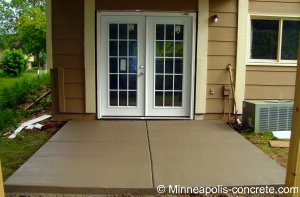612-470-8575
Thinking of Buying or Selling? We have top real estate partners nationwide! Reach out first for expert guidance and a home value report. Click the "Request a Quote" Button to connect!
DIY Concrete (Do-It-Yourself)
Get complete diy concrete patio instructions here. From preparing the ground to maintenance, learn what to do and what to watch out for. Before you begin any concrete project, know what you're trying to accomplish. Plan the budget and dimensions of your project. Your budget, time and landscaping will determine the size, shape, color, and texture.
Make sure you have the tools needed to pour a project yourself.
For the sake of simplicity, these directions walk you through creating a small, square, standard concrete patio.
Steps for a DIY Concrete Patio
Step #1
Prepare the ground - Determine if the ground is stable. If not, remove impediments and place fill in the ground. For considerations and steps, click Cutting Sod and Preparing the Ground.
Step #2Concrete Forms - Set-up forms in the shape you want. For a basic, square concrete patio, obtain lumber (most common are 2X4's), nail screws, and steel or wood stakes. You may also use metal or plastic forms if you're planning on doing many concrete projects, but these are expensive and typically used by professionals. Wood forms will warp over time, but will be fine for this project. Click concrete forms for diy steps to set up your patio.
Step #3Compacting the fill and Final Grade - Make sure you have the ground prepared at the proper height for a pour. You'll need to add fill and make sure it's compacted to create a nice base upon which to pour your patio.
Step #4DIY Concrete Reinforcement - High quality and durable patios usually have some type of reinforcement. Reinforcements are typically used on exterior projects in cold regions like Minnesota because of the freeze/thaw cycle. This cycle causes the ground to move. Typical reinforcements are fiber mesh, rebar and wire mesh. Learn how to install reinforcements here.
Step #5Install Concrete Expansion Joints - This is an essential step in any area that undergoes the freeze/thaw weather cycle. It's especially important in Minnesota. Learn how to install expansion joints here.
Before you move on to step #6, click here for specific instructions on how to stamp concrete, if this applies to your project.
Step #6Order Your Concrete or Make Your Own - We suggest that you only make your own concrete if your project is under 100 square feet because the consistency will not be the same throughout the patio by mixing several batches. It may also take more time and possibly money to do the project if you don't have the equipment to mix the concrete yourself. We suggest you find a ready-mix concrete supplier in your area and have them deliver it pre-mixed for you. Click concrete delivery to find out what to order.
In addition.....
To avoid potential problems with the concrete, you may need some first aid treatments to help with the pour. Click concrete mix to find out if you'll need some pre-packaged admixtures on hand.
Step #7DIY Concrete Pouring - The first thing to be considered in pouring concrete is the accessibility of your project. If you're not making your own concrete and a concrete truck needs access to your project, you may risk landscape damage from the truck.
To avoid this, you can either get several people to push wheelbarrows full of concrete from the concrete truck in the street to your patio site, or you can rent a power buggy (a motorized wheelbarrow that holds more concrete). A final option is to rent a concrete pump to move the concrete from the truck to your concrete patio site, but this is the most expensive option. Click pouring concrete to learn about the tools and timing for a proper patio pour.
Step #8DIY Concrete Finishing - The key to concrete finishing is the right tools, timing, and the proper technique. This is often the most complicated part of the process and the reason many choose to hire a contractor. Learn the proper tools, timing and technique - concrete finishing.
Step #9Cutting Concrete - This is a preventative, but necessary step. Cut your concrete before it dries with a groover, but this involves some intricate timing. It's easier for a beginner to wait for the concrete to dry and then use a concrete saw to install control joints.
It's important to install control joints because concrete may crack. Instead of having a large, unsymmetrical crack run through the patio, it most often cracks along previously cut control joints, making them unnoticeable. Click here to find out about making wet cuts, saw cuts, and decorative cuts on your patio.
Step #10Curing Concrete - This refers to the time between brooming (step #8) the concrete and when it reaches full strength. Find out what things you can do to speed up or slow down the concrete curing process.
Step #11Seal the Concrete/Maintenance - Sealing the concrete is important to protect it from de-icers, oil, salt and weathering. Sealing makes the concrete finish last longer. Just like wax protects a wood floor, seal your concrete to lock in the color and shine.
Does DIY concrete seem too complicated?
If so, and you live in the Minneapolis and surrounding suburbs area, request a quote on your project.License # BC721668






New! Comments
Have your say about what you just read! Leave me a comment in the box below.